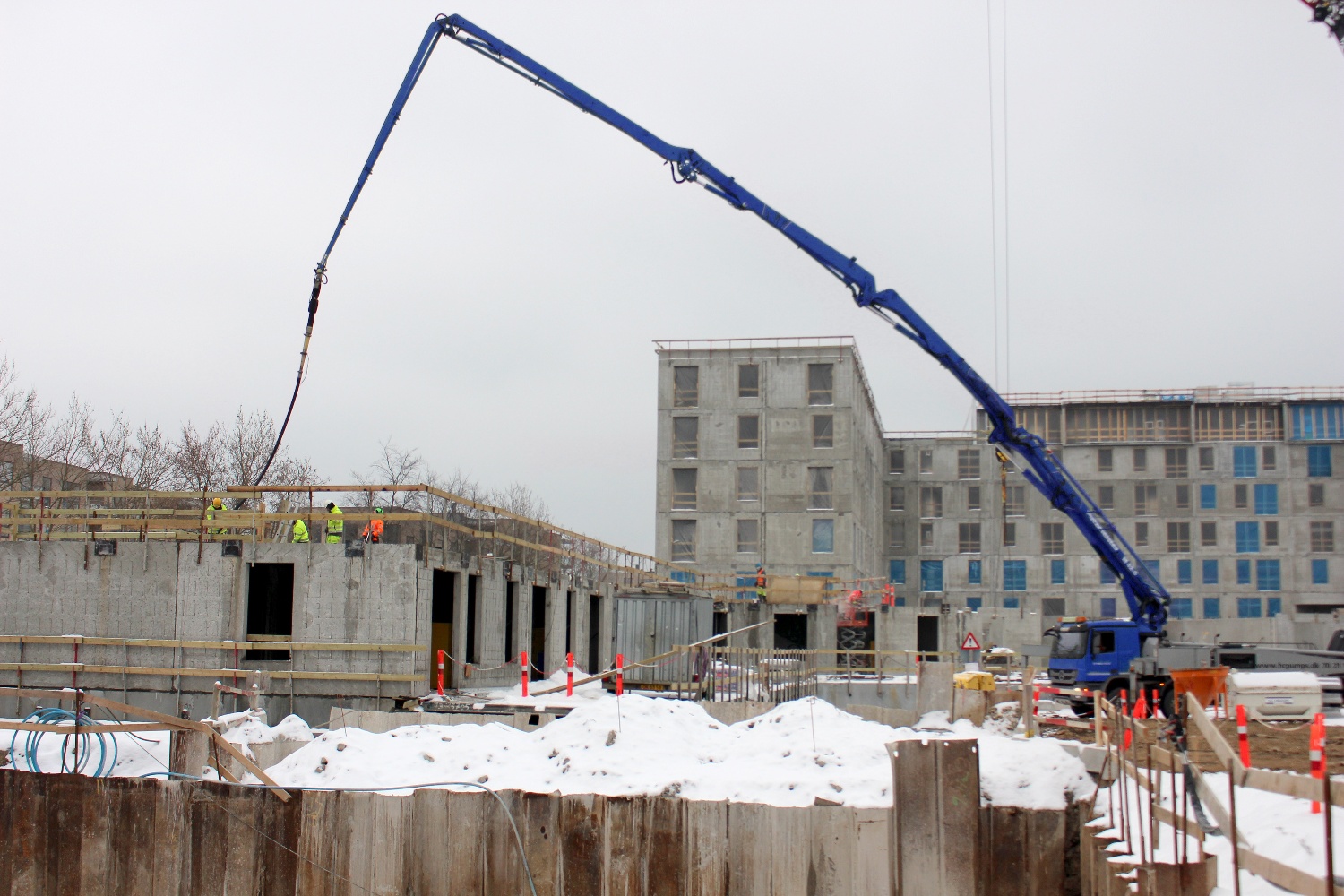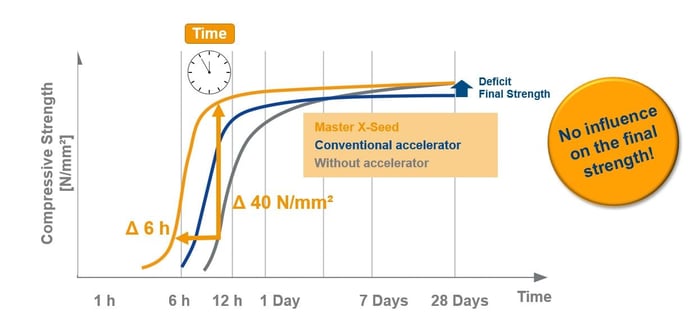When concreting in winter, special measures must be taken both during production in the ready-mixed concrete plant and during processing and post-treatment on the construction site, so that frost, snow, rain, and wind don’t negatively impact the concrete or the quality of the component. Here are eight things you need to know about concrete in winter.
1. Winter concreting takes planning
Just as concreting at summer temperatures involves taking special measures and planning with foresight, concreting at low winter temperatures has its own complications to consider. And it’s a broad spectrum: when we talk about winter weather conditions, that covers everything from ambient temperatures below +5 °C to snow, ice, and strong winds – all of which can affect concrete.
Ambient and fresh concrete temperature, as well as the nature and proportions of the starting materials, have a powerful influence on the strength development of the concrete.


2. Temperature influences setting behavior
The hydration of cement and water is an exothermic chemical reaction. Every chemical reaction is temperature-dependent and, at low temperatures, chemical reactions are slower (the rule of thumb is that the reaction speed halves or doubles for each ΔT = 10 °). When water freezes in fresh concrete, the hydration reaction stops. The result is delayed setting and hardening. Even in young concrete that has already set, freezing can cause damage. Remember that, in addition to the tests according to DIN 1045-3, the fresh concrete temperature must also be measured.
3. A lot of things can go wrong
The risks and consequences of improper winter concreting range from delayed strength development to temperature differences in the cross-section, delayed green strength, sedimentation and bleeding, frozen unbound water, and dark discoloration of the concrete surface.
4. You can influence fresh concrete’s temperature in winter
There are plenty of variables to take into consideration that you have the opportunity to change. For example, there’s the temperature of the raw materials and the mixing temperature, the time taken for transportation to the site, the installation temperature, and the temperature of the concrete itself. So think about making warm concrete: An increase in the fresh concrete’s temperature by 1 Kelvin requires a temperature increase of the cement (10 kelvin), mixing water (3,5 kelvin) and aggregates (1,6 kelvin).
How to produce warm concrete:
- Store your starting materials in a protected place and preheat them with suitable heating facilities
- Only use hot mixing water
- Add admixtures as late as possibler
- Try to determine the fresh concrete temperature as accurately as possible
Note: The fresh concrete must have such a high initial temperature that its own heat development prevents it from freezing through too early.
| Air temperature | Minimum temperature of the fresh concrete during placement |
| +5 °C to -3°C |
+5 °C general +10 °C for cement contents < 240 kg/m³ or for LH cements |
| below -3 °C | +10 °C for at least 3 days |
5. Adjusting the concrete design can help
Certain types of concrete offer high hydration heat development or rapid strength development, although such mix designs aren’t suitable for massive structures. To achieve a ‘winter concrete mix’, you can:
- Increase the cement content (> 300 kg/m³)
- Increase the cement strength (for example, CEM I 42.5 R; CEM II/A-LL 42.5 R; if necessary 52.5 R)
- Reduce the water/cement ratio
- Omit additives
However, admixtures can be helpful: for example, you can reduce the water-cement ratio with superplasticizers, adjusted for winter use. You can add freeze protection admixtures such as MasterSet FZP to increase the freeze resistance of green concrete during the cold season and you can also use accelerators, such as Master X-Seed 100, for improved high early-strength development.
Creating summer conditions in winter with Master X-Seed:
The cement hydration with and without Master X-Seed’s Crystal Speed Hardening.

6. Manage the environment to minimize problems
There’s plenty to think about when the temperature drops, from transport routes to keeping work surfaces and scaffolding free of snow and ice. Avoid long transport as well as waiting times during installation (keep to a maximum of 15 minutes) and quickly pour and compact warm concrete. You’ll need to remove snow and ice from the formwork and reinforcement and consider temperature losses with longer pump lines, which may need thermal insulation, as the concrete temperature can drop by up to 3 K per 100 meter conveying distance. Concreting is not permitted on frozen ground, and minimum installation temperatures deviating from DIN 1045-3 must be agreed upon. Also, pay attention to weather forecasts and plan additional measures accordingly.
7. Don’t forget protection, post-treatment and stripping
In the winter, post-treatment will be needed to protect against premature drying, extreme temperatures or temperature changes, mechanical stress and vibrations, and chemical attack.
| Air temperature | Measurements |
| +5 °C to -3 °C |
Cover or spray on after-treatment agent and apply thermal insulation1 (e.g. thermofoils, boarding, lightweight boards,...) Suspend steel formwork with insulation boards |
| below -3 °C |
Cover and apply thermal insulation Workplace enclosure (tent) If necessary, heating (e.g. radiant heater², infrared, dry air) |
1) Protect from moisture penetration; 2) Never irradiate directly with heating units;
Note: Post-treatment with water is not allowed in frosty conditions.
8. Remember what you need the concrete to achieve
Requirements for the concrete in winter include:
- Quickly reaching freeze resistance
- Stripping within a reasonable time period
- Prompt exposure of the construction site/components
- Fresh and hardened concrete properties match those under normal conditions
- High quality standards; if necessary, fair-faced concrete requirements
Bear in mind that to achieve all of these goals, you will need to use a hardening accelerator with optimum influence on early strength in the first four to 48 hours.
To learn more about the benefits of the Master X-Seed hardening accelerator for early strength gain in winter and protection of fresh concrete against freezing, get in touch with our expert Oliver Mazanec, browse through our informative brochure or visit our dedicated product page.


